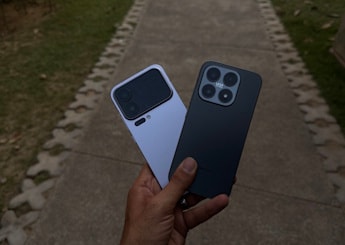- Home
- Social networking
- Social networking Features
- Did Social Media Really Impact the Indian Elections?
Did Social Media Really Impact the Indian Elections?

Facebook, for instance, states that Narendra Modi's fan base grew by 14.86 percent between April 7 and May 12, the duration of the elections. Arvind Kejriwal's count increased by 8.16 percent during the same time. Also, according to Facebook, between the day the elections were announced and May 16, the counting day, 29 million people made 227 million poll-related interactions (posts, comments, shares, and likes), with 13 million people on Facebook posting 75 million updates related to Narendra Modi.
Vikas Pande, a media advisor and volunteer for the BJP campaign, speaks about how social media helped bypass the mainstream media. "The reach that social media has now is vast. In fact even with two of the top YouTube Channels, 'Narendra Modi' and 'I Support Narendra Modi', there has been a hike in the number of subscribers." Pande says that the rise is anywhere in between 10-15 percent. He also goes on to mention that social media played an important role in reaching out to people even in tier-two and tier-three cities. "Even in places like Gorakhpur, the reach of the Internet, no matter how limited, helped voters obtain information, not only about Narendra Modi, but the elections in general."
While there was some debate before the elections on whether or not there was an actual 'Modi wave', online at least, it certainly seemed to be the case, with search trends and Facebook and Twitter numbers showing definite interest in both the BJP and Modi. This was borne out in the election results, with the BJP sweeping the polls.
The website of the Election Commission of India shows that the BJP (Bhartiya Janata Party) won a vote share of 17,16,57,549 votes which accounted to 31 percent of the total votes given. The Congress came in second with 10,69,38,242 votes that accounted for 19.3 percent of the total votes, while the Aam Aadmi Party, which was second only to the BJP in terms of online trends, got 1,13,25,635 - or just about 2 percent - votes. So why the big difference between AAP's virtual world interested and real world performance?
Dr. Ranjit Nair, CEO of Germin8, a company that works on big data analysis, says, "If you see it broadly, the Aam Aadmi Party (AAP) had a fantastic outreach to people, but they failed in their messaging strategy, the BJP on the other hand did not have much of an outreach earlier on (it changed in the latter months) but their message was one that the people wanted to hear, whilst the Congress woke up to the impact of social media messaging just too late."
Going further he also mentions that the impact was felt more on the first-time voters, who wanted to hear a positive message. For instance the AAP, he mentions, spoke about corruption and the problems plaguing the country, but never offered any hope in the form of bringing about a change. "The BJP on the other hand offered the hope which people desperately wanted," Nair says. "The sad part with the Congress was that they really didn't have any story to tell or any message to give. This impacted the decision of the first time voter a lot."
"It's not that that first time voters were brainwashed by the message that the BJP gave, " he clarifies. " It was just that people wanted to hear positivity and also hope for a change, which they got to hear."
Data released by Twitter from January 1 till May 12 shows the graph for the political parties and the rise and fall in the number of tweets. Keeping in sync with real time happenings, the popularity of the BJP soared slowly with the last months leading to the elections showing a huge spike, whilst AAP and Congress were far behind.
SocialBakers, a company that offers tools for monitoring and analysing social media, offers a detailed breakdown of the performance of the main political parties, including the percentage of shares, comments and likes that the posts by the parties and politicians generated.
The trends observed for the time period of April 19 to May 18 show how the popularity of the BJP surged, with Modi-related interactions hitting a record of over 15 lakhs, Kejriwal at just over a lakh and Digvijaya Singh of the Congress at just 19,500. When you look at the performance of these individuals and their parties in the elections, it's easy to infer a relation between social media and actual results.
This is made clearer when you consider the huge amount of activity on Twitter on the counting day - with 2.003 million tweets related to the election in a single day. Rishi Jaitly, Twitter India Market Director says, "Similarly to the Obama campaign, everyone knew that this Lok Sabha election would also be influenced by social media, particularly with over 150 million first-time voters between the age of 18-23 years. Everyone could see Tweets from the main parties, politicians and voters on their mobile devices, on their TV screens or in their daily news reports, or follow key political and media accounts via a missed call to consume their tweets as text messages."
Nair makes another point about the elections. He says that while the 2014 elections saw a glimpse of social media being used, it will be the 2019 elections where its power will be fully utilised. "Five years down the line, political parties, will have fully understood the importance of reaching out to the people in urban and rural India," he says. "Not only that it will also encourage more and more people to come out and volunteer in all these areas. As of now it was more of the urban educated youth that did the volunteering. By then it will be more inclusive."
Catch the latest from the Consumer Electronics Show on Gadgets 360, at our CES 2026 hub.
Related Stories
- Samsung Galaxy Unpacked 2025
- ChatGPT
- Redmi Note 14 Pro+
- iPhone 16
- Apple Vision Pro
- Oneplus 12
- OnePlus Nord CE 3 Lite 5G
- iPhone 13
- Xiaomi 14 Pro
- Oppo Find N3
- Tecno Spark Go (2023)
- Realme V30
- Best Phones Under 25000
- Samsung Galaxy S24 Series
- Cryptocurrency
- iQoo 12
- Samsung Galaxy S24 Ultra
- Giottus
- Samsung Galaxy Z Flip 5
- Apple 'Scary Fast'
- Housefull 5
- GoPro Hero 12 Black Review
- Invincible Season 2
- JioGlass
- HD Ready TV
- Laptop Under 50000
- Smartwatch Under 10000
- Latest Mobile Phones
- Compare Phones
- Honor Magic 8 RSR Porsche Design
- Honor Magic 8 Pro Air
- Infinix Note Edge
- Lava Blaze Duo 3
- Tecno Spark Go 3
- iQOO Z11 Turbo
- OPPO A6c
- Samsung Galaxy A07 5G
- Lenovo Yoga Slim 7x (2025)
- Lenovo Yoga Slim 7a
- Lenovo Idea Tab Plus
- Realme Pad 3
- Moto Watch
- Garmin Quatix 8 Pro
- Haier H5E Series
- Acerpure Nitro Z Series 100-inch QLED TV
- Asus ROG Ally
- Nintendo Switch Lite
- Haier 1.6 Ton 5 Star Inverter Split AC (HSU19G-MZAID5BN-INV)
- Haier 1.6 Ton 5 Star Inverter Split AC (HSU19G-MZAIM5BN-INV)







![[Sponsored] Haier C90 OLED TV | Dolby Vision IQ, 144Hz OLED and Google TV in Action](https://www.gadgets360.com/static/mobile/images/spacer.png)









